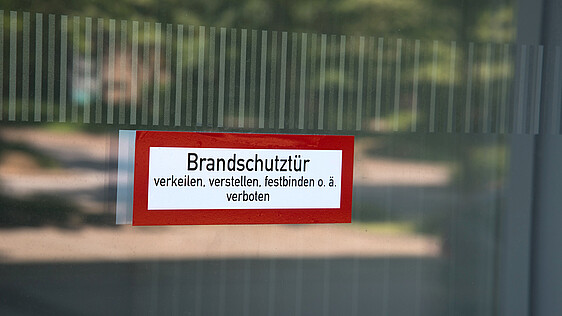
Avoid fires with preventive measures
Thinking and acting with foresight, modern technical equipment and regular in-house training by specialist personnel are the best basis for significantly reducing the risk of fire outbreaks. We continuously support and advise our customers when it comes to innovative fire protection. Our experts Kerstin Schneller, Lukas Hager, Timo Klouth, Frederik Meilwes, Maik Reimann and Florian Rosenbaum work in a cross-functioning team - always with the aim of generating the best possible solutions and helpful tips for our customers. For greater resilience and security, there is also a regular, intensive exchange with our industrial broker deas and our logistics broker Schunck.
The detailed examination of the origins and multifaceted consequences of fire incidents is part of the everyday work of insurance experts. Any incident can have a serious impact on a company's operations. “Such losses generally cause premiums to rise and it is becoming increasingly difficult to obtain insurance cover for such risks. Below we present some measures that can help prevent fires in facilities,” explains Frederik Meilwes, head of our risk management company. Every preventative measure that is successfully implemented is a step towards a safer environment for patients, residents and staff, as well as maintaining operations. Active participation and an individual sense of responsibility are essential to achieve this goal.
– Kerstin Schneller, Head of Claims Field Service and Industry (Ecclesia)Loss experience teaches us time and again that attentiveness, open eyes and ears could prevent many fires. Keeping fire doors open with good intentions, people with a tendency to aggression and operational blindness are more often involved than you might think.
Clear rules: Patients, residents and staff may only use sources of danger and ignition such as lighters and matches to light cigarettes and other tobacco products outside the building or in specially designated areas. Clear house rules must be laid down and, for example, smoking areas must be designated.
Use of surveillance technology: Surveillance cameras and other technical aids can help to detect and prevent suspicious behavior at an early stage. The personal rights of patients and employees must be respected.
Store materials safely: Flammable materials required in clinical operations must be stored safely and out of the reach of patients. This applies in particular to cleaning agents, disinfectants and other chemicals. Corresponding areas must be locked so that only authorized personnel have access. The number of keys or access chips should be kept to a minimum.
Use of safe materials: When possible, flame-retardant materials should be used in the respective facility. This applies in particular to furniture, bed linen, curtains and covers. Flame-retardant textiles and furniture can significantly slow down or even completely prevent the spread of fire. This saves valuable time for evacuation and firefighting.
Minimize the use of paper and cardboard: As these materials are highly flammable, they should be avoided in residents' and patients' rooms and in corridors wherever possible. Important documents should be digitized and stored securely for protection.
– Florian Rosenbaum, Senior Kundenbetreuer Region Süd (Ecclesia)In view of the hardening of the property insurance market, the consistent implementation of preventive measures is becoming increasingly important, not only from an ethical but also from an economic point of view.
Optimization of fire protection measures
Regular maintenance: Fire alarm systems should be serviced regularly and checked for functionality. Manipulation by covering or masking can be prevented by suitable technical measures, such as the use of cover protection devices.
Switching off ventilation systems: These should be designed so that they can be switched off immediately in the event of a fire in order to prevent the fire from spreading. This can be ensured by a direct connection to the fire alarm system.
Fire doors and walls: Their use can significantly slow down the spread of fire within the building. This can save valuable time for evacuation and firefighting.
Emergency lighting and escape route markings: Functioning emergency lighting and clearly visible escape route markings are essential to ensure safe evacuation in the event of a fire.
– Maik Reimann, Risk Consultant (Schunck)Comprehensive risk management is crucial for effective fire protection. Regular risk analyses allow potential hazards to be identified and avoided at an early stage.
Training and sensitization of staff
Regular training: Employees should be regularly trained in fire safety and evacuation measures. This training should include theoretical and practical elements and be carried out by external experts. Trained and sensitized personnel can notice and remove possible impairments to the automatic closing ability of fire doors - for example due to wedges, small cords on the handles or heavy objects - during operation. To avoid such incidents, it makes sense to install hold-open systems. Depending on the design, these can also be connected to the fire alarm system.
Raise awareness of fire hazards: Security staff and other employees should be specially sensitized to dealing with potential fire hazards. This also includes regular information events and workshops.
First aid training: As injuries can also occur in the event of a fire, all employees should receive regular first aid training.
– Lukas Hager, Risk Consultant (deas)As an experienced firefighter, I know how quickly fires can start and how quickly fire and smoke can spread. Prevention is the best and simplest protection to save lives and property.
Organizational measures
Creation and updating of emergency plans: Each area of the facility should have a detailed emergency plan that is regularly updated. This plan should contain clear instructions on what to do in the event of a fire, including responsibilities and communication channels. In addition, there should be an overarching alarm and response plan that sets out the general "rules of the game" in an emergency/crisis situation. Prepared documents - such as occupancy plans - can also be used to provide the fire department with relevant information as quickly as possible. In addition to the emergency plans, we also recommend that the fire department plans and fire safety regulations are always kept up to date.
Regular fire drills: To ensure that everyone knows what to do in an emergency, fire drills should be carried out regularly. These drills should cover different scenarios and involve both staff and patients. After each drill, a debriefing is recommended to identify and address any weaknesses. It is recommended to involve the local fire department in such drills.
Fire safety officer: A fire safety officer should be appointed who is responsible for monitoring and implementing all fire safety measures. In many cases, this is required by law. If this is not the case, we still strongly recommend it. This person should work closely with the fire department and other relevant authorities and attend regular training and refresher courses. Appointing a fire safety officer will help to increase the safety of all employees, identify potential fire risks at an early stage and ensure effective emergency response.
– Frederik Meilwes, Head of Risk Management (Ecclesia)In an emergency, the aim is to control clinical processes in such a way that the primary protection goal - the safety of people - can be ensured as best as possible. Staff should be able to move from the chaos phase to orderly processes as quickly as possible. This is only possible if I plan proactively rather than reacting to situations.
Routine inspections: Regular inspections of the premises by internal and external experts can help to identify and rectify potential fire hazards at an early stage. These inspections should be documented and the results communicated to management.
Documentation and reporting: All fire protection measures and incidents must be carefully documented. Regular reports to management help to monitor the effectiveness of the measures taken and make any necessary adjustments.
Patient education: Patients should also be informed about fire safety measures in the facility and made aware of them at regular intervals. This can be done through information events, notices in communal areas and individual discussions with patients.
Interdisciplinary cooperation: Cooperation between medical staff, security staff and technical staff is essential. Regular meetings and the exchange of information help to ensure that all departments are on the same page and work together efficiently.
– Timo Klouth, Team leader architects (Ecclesia)Many fires are caused by human error, whether intentional or unintentional. A conscious approach to potential sources of danger can significantly reduce the likelihood of a fire occurring.
